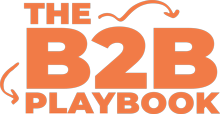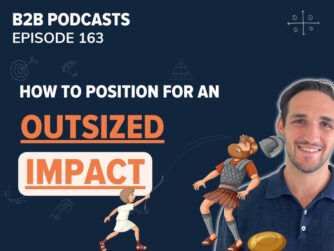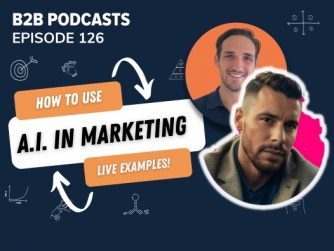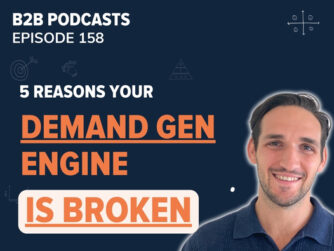How do you create a Demand Generation content strategy that that’s simple to execute, and extremely effective? One that stands out from the competition, and builds trust with your Dream Customers?
A great content strategy is the heartbeat of any Demand Generation program. It should (a) get your Dream Customers to prioritize the problem that your business solves, and (b) lead them to the logical conclusion that you’re the perfect business to help them do that.
Today we’re sharing our Demand Generation Content framework with you step-by-step. At the end as a bonus, we’ll also give you a really simple way for thinking about how to get that content in front of your Dream Customers, so it has the impact you need.
This is part of our Demand Gen mini-series. You can access the full series and their whiteboarding sessions here:
- What is demand generation? (part 1)
- When is the right time to start demand generation? (part 2)
- What companies are suited to demand generation? (part 3)
- How to build a winning business case for demand generation? (part 4)
- 10 questions to decide if you should build a new demand gen strategy (part 5)
- 5 steps to transition from lead gen to demand gen (part 6)
- Our B2B Demand Generation framework, The 5 BEs (part 7)
- Content That Generates Demand (part 8)
- Budgeting for Demand Gen – creation vs capture (part 9)
- Demand Generation KPIs (part 10)
- B2B Demand Generation Marketing Tech Stack (part 11)
- An introduction to Sales & Marketing Working Together (part 12)
- Our Sales & Marketing Alignment Workbook (part 13)
- Build Your Demand Generation Engine in our 12 Week Course
As per usual, you can read, watch or listen below to work through our Demand Generation Content framework.
Listen To The Episode
This episode is sponsored by Leadfeeder. Know EXACTLY who is coming to your website, convert more leads and get a free trial at Leadfeeder.com.
➡️Grab your Leadfeeder extended premium trial here
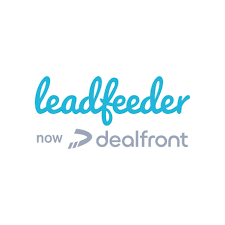
Watch The Episode
What Role Does Content Play in Demand Generation?
Content is what helps convince your Dream Customers that (a) the problem you solve for them is worth prioritising, and (b) you’re the perfect company to help them solve it.
If you’ve done really solid customer research to deeply understand your customers’ pains, Jobs-To-Be-Done (JTBD), objections and goals – then your content is going to help address all of these.
Content is the bridge of trust that you need to build to take someone from being a target prospect through to a paying customer.

This bridge can be seen as their buying journey – and it’s all the information they need to progress through it, realise they need to address this problem, and that you’re the perfect company to help them do it.
Understand Demand and the Buyer’s Journey
Most businesses are fighting over scraps when it comes to demand generation. They’re so focused on the tiny 3-5% of buyers who are ‘ready to buy’ right now, that that they completely miss the bigger opportunity.
Imagine your ideal customers in a big swimming pool. The 3-5% ready to buy now? Those are the fish everyone is fighting over. And as time goes on, more and more sharks enter the pool, competing for a limited number of fish. But the real opportunity? The fish swimming in a blue ocean the other sharks haven’t even seen.

Demand gen requires you to ‘capture demand’ in that small, competitive pool to start with. After all, your business needs to eat. But it’s also about nurturing relationships with the massive pool of potential customers who don’t even know they need you yet. And how do you reel them in? With content that builds trust with them, that addresses all of those customer’s pains, their jobs to be done, objections and goals. That content is the “bridge of trust” to guide those thoroughly unaware prospects to the logical conclusion that you’re the perfect partner.
The 5 Stages of Awareness – Your Demand Gen Content Blueprint
This framework is gold, my friends. The 5 Stages of Awareness are the blueprint for mapping your content to the actual journey a potential customer would go through to work their way into buying your product.
If you build content for each stage, you will completely map the buying journey. I’ll give an example of how an insurance company used this framework recently to make me purchase cybersecurity insurance!
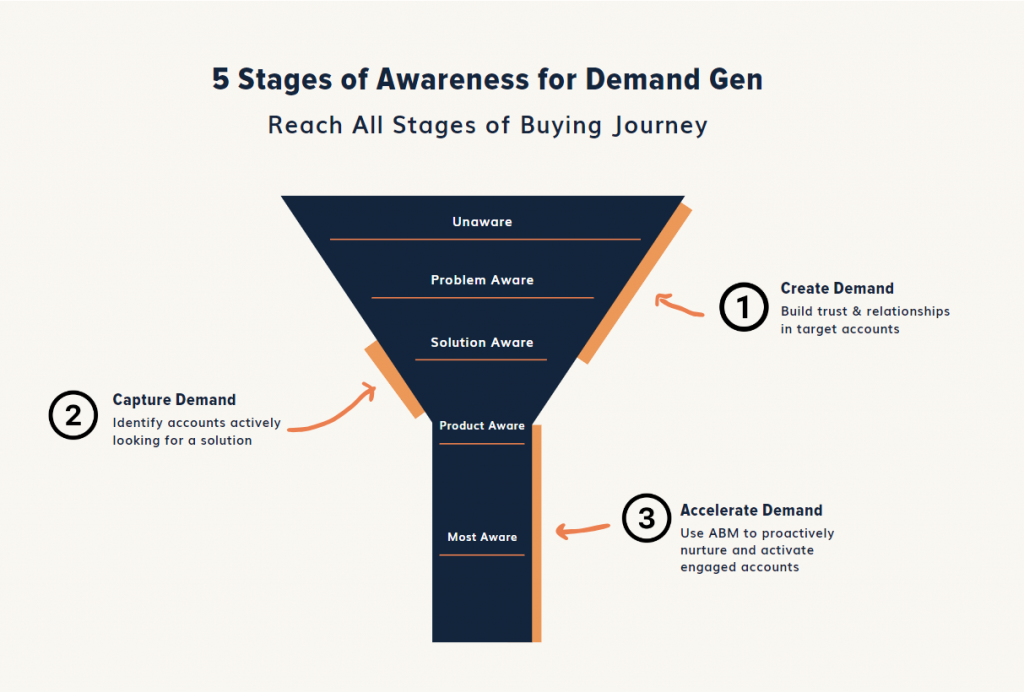
Stage 1 – Unaware
The first stage of awareness is ‘unaware’. At this stage, potential customers are not even aware that they have a problem or a need that your product or service can address.
Like when I was completely oblivious to the need for cyber insurance until Kevin pinged me on slack with an article about a business getting hacked. It was a business that was really similar to ours, and it was a disaster for them. That scared the sh*t out of me.
Wham – we got jolted into the Problem Aware stage real quick.
Stage 2 – Problem Aware
The second stage of awareness is ‘problem aware’. Here, customers realize they have a problem but are exploring what it means for them and their business. They may not know the solutions available.
In the problem aware phase, we were looking at more articles around the potential issues stemming from a cybersecurity hack. We saw it meant a loss of reputation for us, damaging consequences for our clients if their passwords were leaked, potentially our business shutting down. Everything we worked so hard for, gone in an instant.
That then started getting us looking for solutions.
Stage 3 – Solution Aware
The third stage of awareness is ‘solution aware’. Here, customers are exploring different solutions to their problem, but may not be familiar with your specific product or service.
Proceeding with our cybersecurity example, at this stage we looked at what are the different ways that we could try and solve for this problem? Can we look at storing our passwords in a safer way? Maybe we should also get insurance? One part was – we really wanted to prevent this from happening in the first place.
And the second part was – if it does happen, are we covered? So if something happens, we don’t have to shut our business down and we can keep moving on. So we did our research, looking at the different types of insurance available and different ways to store passwords more securely.
Stage 4 – Product Aware
The fourth stage of awareness is ‘product aware’. Here, customers know about your product or service but are comparing it to others on the market.
And we were in that product aware phase where we were comparing different cybersecurity solutions in the market against each other. And some cybersecurity solutions cover you for different things. We operate out of Australia, but we have clients all over the world.
So some only covered you domestically, others covered you internationally. And so it was really important to see who did what and compare them against each other. And then finally, once we had really nailed down one that we thought was great, we looked at reviews for the insurance product.
Stage 5 – Most Aware
The fifth and final stage of awareness is ‘most aware’. Here, customers are fully aware of your product, including its benefits and how it compares to competitors. They are on the brink of making a purchase decision. The just need something extra to push them across the line.
For us with cybersecurity insurance, we’d set aside a date to do it before the new year. This was an internal pressure we put on ourselves, but you can put external pressure on your Dream Customers with sales, limited offers – and other things that trigger them to ‘act now’.
Create Content that Make Their Lives Better (Even Before They Buy!)
A fantastic mindset for creating content is to try and makes the lives of your Dream Customers better before they buy. When you start creating really valuable content that genuinely helps people, it builds a relationship of trust between that person and your brand. Think about how Hubspot do that with their certifications and training? You can use their certifications to upskill in an existing job, or maybe even help you land a new role.
When the discussion comes up as to “which CRM should we use”, you’ll have a lot of faith in and think of Hubspot.

Example of Next Level Relationship Building Content
An awesome example of this is a past student from our Demand Gen program, The B2B Incubator. The CMO of Rivet used our program to build a content system that creates deep trust with their future buyers.
Rivet’s software helps contractors with labour management, so they build more accurate labour plans and meet customer timelines.
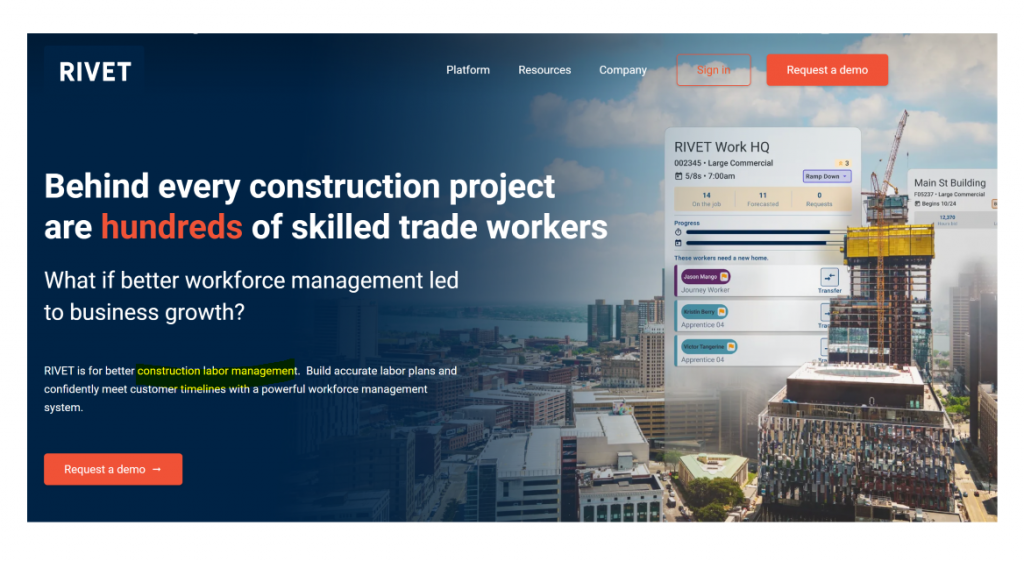
Going through our Demand Gen program, Rivet nailed down who their ‘best customers’ were, and created the ‘Construction is Hard‘ show. This show addressed the pains of their ideal customers, and brought in subject matter experts to offer solutions to their listeners and viewers.

The results have been huge, with the CMO telling us their Dream Customers are booking demos from emails about their latest episode. It turned marketing into the primary driver of qualified pipeline, and positioned them as thought leaders in their industry. They’ve also had feedback from their audience that they feel heard in a way that they never have been before.
The podcast doesn’t talk about their software often, but it’s a natural conclusion of the problems addressed on the podcast.
Want to build something like this for yourself? Check out our 12 week Demand Gen program that gives you everything you need.
Get Your Content In Front Of Your Dream Customers
You can create the most mind-blowingly awesome content on the planet, but if your dream customers can’t actually see it, what’s the point? That’s why you need to get strategic about distribution.
Distribution is just a fancy way of saying: get this content in front of your Dream Customers’ eyeballs.

When you speak to your Dream Customers, you’ll address them in one of three ways:
- One-to-many
- One-to-few
- One-to-one
Let me explain.
Content Distribution: One-to-Many
The one-to-many is your big broad reach.

Think advertising, organic social posts, YouTube videos, newsletters – even forum posts. These should be wherever it is your Dream Customers hang out. You’re reaching many eyeballs at once.
Content Distribution: One-to-Few
Then you’ve got the one-to-few channels, where you’re speaking to a smaller, more defined audience.

Examples of 1:few communications include webinars, in-person events, or even through relevant industry associations. Your content here can be more targeted to specific slices of your audience.
Content Distribution: One-to-One
Finally, you’ve got one-to-one touchpoints.

The one-to-one touchpoints include personalized emails, calls, video meetings. This is where you get hyper-focused on individual prospects, and their personal needs.
Advice On Using The 3 Levels of Distribution
The key is creating a mix of all three, gradually getting more personalized as prospects move further down the funnel. Why? Because you want to avoid having a one-to-none situation, where your premium content is just sitting there, undiscovered by the people who need it most.
Even the best show can’t succeed without proper distribution and promotion. Your content can’t help them and build relationships with future customers if they can’t find it.
Next Steps (Action For You To Take)
If you follow the steps in this guide, you’ll build content that creates trust, solves problems, and positions your business as the go-to solution for your dream customers.
Action Steps:
- Define your dream customers and map their buyer’s journey using the five stages of awareness framework.
- Create content that addresses each stage, providing value and solving problems even before customers purchase your product or service.
- Implement a multi-channel distribution strategy, leveraging one-to-many, one-to-few, and one-to-one channels to maximize reach and personalization.
- Explore content collaborations and repurposing techniques to fuel your content engine and build warm relationships with potential customers.
We Show You Exactly How To Do This
Want someone to show you exactly how to do this, step-by-step? That’s what we do in our 12 Demand Gen program, The B2B Incubator.
It gives you the strategy, templates and tools to build relationships with future customers and drive consistent pipeline for your brand.
Check out The B2B Incubator here and see why so many B2B marketers like you love it.
